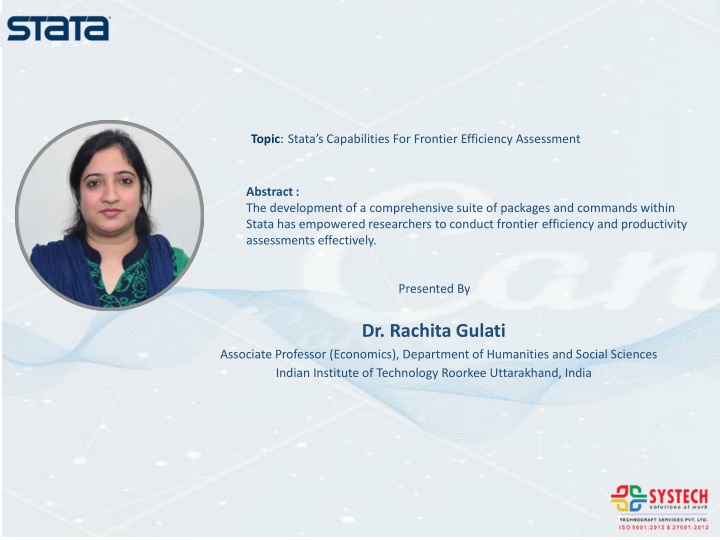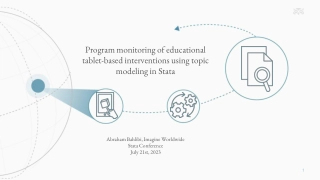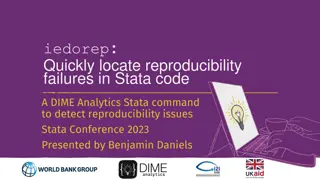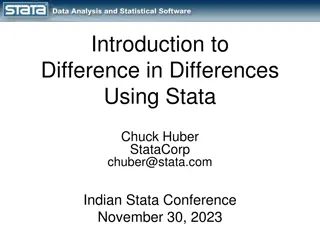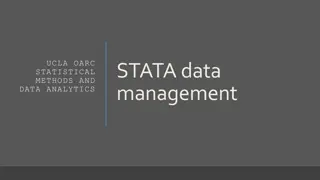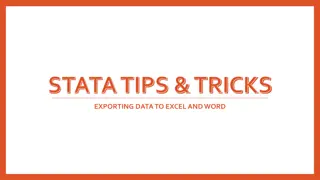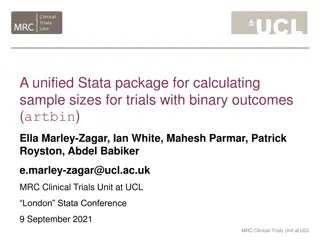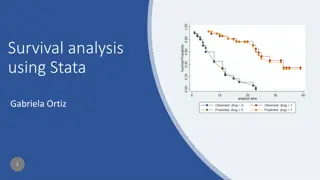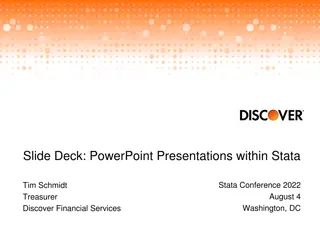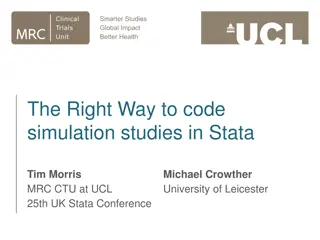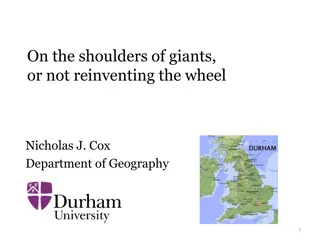Stata's Capabilities for Efficiency and Productivity Assessment
Stata offers a range of tools for conducting frontier efficiency and productivity assessments, including nonparametric and parametric approaches, technical efficiency modeling, different orientations in DEA, productivity estimation techniques, and popular models like MPI and MLPI. The software empowers researchers to analyze efficiency and productivity in various sectors effectively.
Download Presentation

Please find below an Image/Link to download the presentation.
The content on the website is provided AS IS for your information and personal use only. It may not be sold, licensed, or shared on other websites without obtaining consent from the author.If you encounter any issues during the download, it is possible that the publisher has removed the file from their server.
You are allowed to download the files provided on this website for personal or commercial use, subject to the condition that they are used lawfully. All files are the property of their respective owners.
The content on the website is provided AS IS for your information and personal use only. It may not be sold, licensed, or shared on other websites without obtaining consent from the author.
E N D
Presentation Transcript
Topic: Statas Capabilities For Frontier Efficiency Assessment Abstract : The development of a comprehensive suite of packages and commands within Stata has empowered researchers to conduct frontier efficiency and productivity assessments effectively. Presented By Dr. Rachita Gulati Associate Professor (Economics), Department of Humanities and Social Sciences Indian Institute of Technology Roorkee Uttarakhand, India
Points to Discuss Nonparametric approaches (DEA, FDH) Parametric approaches (SFA, TFA, RTFA) Technical efficiency (TE) Radial vs. Non-radial TE measures Orientations in DEA(Input and Output Orientations) Returns-to-ScaleAssumptions Efficiency Measurement Approaches Productivity Estimation and Decomposition Malmquist Productivity Index (MPI) Malmquist Luenberger Productivity Index (MLPI) 30/11/2023 IndiaStata User Meeting2023_RachitaGulati 2
Production technology Inputs: Single-input and single-output case x = (x1,x2,...,xm) Output: Orientationsin efficiency measurement Input-oriented Output-oriented y = (y1, y2,..., ys) Feasible production plan, if y can be produced from x T = (x, y): y can be produced from x 30/11/2023 IndiaStata User Meeting2023_RachitaGulati 3
Two popular approaches Here, we are trying to assess Stata s capabilities in efficiency and productivity estimation using these two popular approaches. 30/11/2023 IndiaStata User Meeting2023_RachitaGulati 4
Efficiency and Productivity Models Technical Efficiency Models DEA-based Charnes, Cooper, Rhodes (CCR) (1978) Model Banker, Charnes, Cooper (BCC) (1984) Model Slacks and RTS-based Estimation Directional Distance Function (DDF) Model (Radial and Nonradial) (Chung et al., 1997) SFA-based Stevenson (1980) Model Meeusen and Van den Broeck (MB) (1977) Aigner et al. (1977) Model Productivity Change Models Malmquist Productivity Index (MPI) Malmquist Luenberger Productivity Index (MLPI) 30/11/2023 IndiaStata User Meeting2023_RachitaGulati 5
Efficiency vs. Productivity Decision making units (DMUs) are used to describe the production entity responsible for turning inputs into outputs in instances when the firm may not be entirely appropriate, like power plants, schools, banks, states or countries, etc. j =1,2,...,n Productivity is a ratio of output to input Productivity= output/input Efficiency is a relative concept Efficiency= productivity/maximum productivity 30/11/2023 IndiaStataUser Meeting2023_RachitaGulati 6
Data Envelopment Analysis (DEA) DEA is a data-oriented and non-parametric based frontier approach First originated by Charnes, Cooper and Rhodes (CCR) (1978) Charnes, A., Cooper, W.W., and Rhodes, E. (1978), Measuring efficiency of decision making units , European Journal of Operational Research, 2, 429-444. CCR generalized Farrell s (1957) radial measure of technical efficiency to multiple input, multiple-output cases. Farrell, M. J., (1957), The measurement of productive efficiency , Journal of the Royal Statistical Society, Series A, Vol.120, No. 3, pp. 253-290. DEA is a non-parametric, frontier-based approach for measurement of efficiency and productivity. 30/11/2023 IndiaStata User Meeting2023_RachitaGulati 7
I. Charnes, Cooper and Rhodes (CCR) (1978) CCR gives information on the technical efficiency (TE) of a unit using Shephard s distance function Assumptions: Constant Returns to Scale Strong disposability of inputs and outputs Convexity of Production Possibility Set Two distinct variants of the CCR model- Input-oriented CCR (CCR-I Output-Oriented CCR (CCR-O) 30/11/2023 IndiaStata User Meeting2023_RachitaGulati 8
CCR Model Consider n production units (j=1, ..,n) x vector of inputs (where xijis quantity of ithinput (i=1, .m) y vector of outputs (where yrjis the quantity of rthoutput (r=1, .,s). Input-Oriented CCR Model ?? ???= min????? ? ? ???????? ?????? ? ??=1 ? ??????? ??? ??=1 ??? 0 ?? = 1, .? Output-Oriented CCR Model ?? ???= max????? ? ? ? ??,?? ? ? , ? ? ? ?? = 1, .? ???????? ???? ??=1 ?? = 1, .? ??? ? ??????? ?????? ? = 1, .? ? = 1, .? ? ?? ??=1 ??? 0 ?? = 1, .? ?? ???measures the input-oriented TE of ? production unit o ?? ???measures the output-oriented TE of ? production unit o Maximum possible (radial) contraction in inputs IndiaStata User Meeting2023_RachitaGulati 30/11/2023 9
Software/Package/P rogramme DEAP DEAFrontier Matlab R Frontier Methods DEA DEA DEA DEA and SFA Reference Coelli (1996) Zhu (2014) DEA Toolbox additiveDEA (Soteriades, 2017); Benchmarking (Bogetoft and Otto, 2010, 2015); FEAR (Wilson, 2014); Frontier- Frontiles (Daouia and Laurent, 2015); Nonparaeff (Oh and Suh, 2013); npsf (Badunenko et al., 2017); Productivity (Dakpo et al., 2016); semsfa (Ferrara and Vidoli, 2015); SFA (Straub, 2015); spfrontier (Pavlyuk, 2016); SSFA (Fusco and Vidoli, 2015); TFDEA (Shott and Lim, 2015); rDEA (Simm and Besstremyannaya, 2016); DJL (Lim, 2016). frontier, xtfrontier Kumbhakar and Wang (2015) Tauchmann(2012) Stata Packages: - DEA (Ji and Lee, 2010); SFA (Kumbhakar et al., 2015); sfcross (Belotti et al., 2013); sfpanel (Belotti et al., 2013); tenonradial, teradial, teradialbc, nptestind, and nptestrts; (Badunenko and Mozharovskyi, 2016); Stata DEA and SFA Additional Software/Packages: Python, GAMS, SAS, DEAExcel, DEA-Solver-Pro, MaxDEA, DPIN, TFPIP, Frontier, LIMDEP, Inverse DEA, PIM Soft Source:Adapted from Daraio et al. (2019) 30/11/2023 IndiaStata User Meeting2023_RachitaGulati 10
CCR Model: Application in Stata Technical information: Stata 11.2 and above installation required (Badunenko and Mozharovskyi, 2016)) Badunenko, O., and Mozharovskyi, P. (2016). Nonparametric frontier analysis using Stata. Stata Journal, 16(3), 550 589. Syntax teradial outputs = inputs (ref outputs = ref inputs) if in, rts (rtsassumption) base (basetype) ref(varname) tename(newvar) noprint Specification outputs = list of output variables inputs = list of input variables rts (rtsassumption) = specifies the returns to scale assumption. Use rts(crs) for CRS, rts(nirs) for NIRS and rts(vrs)for VRS base (basetype) = specifies the type of optimization. Use base(output)for output- oriented measure and base(input) for input-oriented measure tename(newvar) = creates newvar containing the radial measures of technical efficiency 30/11/2023 IndiaStata User Meeting2023_RachitaGulati 11
Contd Syntax for CCRI and CCRO teradial outputs = inputs (ref outputs = ref inputs), rts (rtsassumption) base (basetype) tename(newvar) . teradial Y=X1 X2, rts(crs) base(output) tename(CCRO) Hypothetical Sample Data X1 X2 Y 2 5 1 2 4 2 6 6 3 3 2 1 6 2 2 30/11/2023 IndiaStataUser Meeting2023_RachitaGulati 12
II. Banker, Charnes and Cooper (BCC) (1984) Model Banker et al. (1984) as an extension of the CCR Model. Based on the variable returns to scale Banker, R. D., Charnes, A., & Cooper, W. W. (1984). Some Models for Estimating Technical and Scale Inefficiencies in Data Envelopment Analysis. Management Science, 30(9), 1078 1092. Two variants: BCC-I and BCC-O Input-Oriented BCC Model ?? ???= min????? ? Output-Oriented BCC Model ?? ???= max????? ? ? ? ??,?? ? ? , ? ? n n j?ij ??BCC? i = 1, .m j?ij ?io i = 1, .m o io Con vexity j=1 j=1 n n j?rj ??BCC? r = 1, .s j?rj ?ro j=1 ? ???= 1 ??=1 r = 1, .s o ro j=1 ? ???= 1 ??=1 ?? = 1, .? ?? = 1, .? j 0 j 0 30/11/2023 IndiaStata User Meetin g 2023_RachitaGulati 13
BCC Model: Application in Stata Syntax teradial outputs = inputs (ref outputs = ref inputs) if in , rts (rtsassumption) base (basetype) ref(varname) tename(newvar) noprint Here, specify vrs in rts() Specification outputs = list of output variables inputs = list of input variables rts (rtsassumption) = specifies the returns to scale assumption. Use rts(crs) for CRS, rts(nirs) for NIRS and rts(vrs)for VRS base (basetype) = specifies the type of optimization. Use base(output)for output- oriented measure and base(input) for input-oriented measure tename(newvar) = creates newvar containing the radial measures of technical efficiency 30/11/2023 IndiaStata User Meeting2023_RachitaGulati 14
BCC Model: Application in Stata . teradial Y=X1 X2, rts(vrs) base(output) tename(BCCO) Hypothetical Sample Data X1 4 7 12 10 9 X2 9 3 8 6 8 Y 10 8 16 9 7 30/11/2023 IndiaStata User Meeting2023_RachitaGulati 15
Computation of slacks and RTS properties *= min j (Objective) o , ,s ,s+ subject to jxij+s = xio j=1 jyrj s+= yro j=1 s ,s+, j 0 n i =1,2,...,m; (Input) n r =1,2,...,s; (Output) j =1,2,...,n (Non-negativity) 30/11/2023 IndiaStata User Meeting2023_RachitaGulati 16
dea: command Alternative command, to obtain efficiency and slacks Ji, Yong-Bae and Choonjoo Lee (2010), Data envelopment analysis , Stata Journal 10(2): 267- 280. st0193.pkg dea ivars = ovars [if] [in] [, rts(crs | vrs | drs | nirs) ort(in | out) stage(1 | 2) trace saving(filename)] where the options are: rts(crs|vrs|drs|nirs) specifies the returns to scale. The default is rts(crs) ort(in|out) specifies the orientation. The default is ort(in) stage(1|2) specifies the way to identify all efficiency slacks. The default is stage(2) trace save all sequences and results from Results window to dea.log saving(filename) save results to filename. 30/11/2023 IndiaStata User Meeting2023_RachitaGulati 17
dea: command X1 4 7 12 10 9 X2 9 3 8 6 8 Y 10 8 16 9 7 dmu 1 2 3 4 5 30/11/2023 IndiaStata User Meeting2023_RachitaGulati 18
III. Directional Distance Function (DDF) Chung et al. (1997) developed this model Simultaneous adjustment of undesirable inputs and outputs along with the desirable inputs and outputs. Chung, Y .H., Fare, R., & Grosskopf, S. (1997). Productivity and undesirable outputs: a directional distance function approach. Journal of Environmental Management, 51, 229 240. Weak disposability of undesirable output. Radial DDF Model ? ?,?,?, ??, ??, ?? = ???? ?,?? ? ???????? ???? ???? ?? = 1, ? where b is undesirable output, o is the unit under consideration and ( ??,??, ??) is the directional vector. ??=1 ? ??????? ???+ ???? ? = 1, ? ??=1 ? ???????= ??? ???? ? = 1, ? ??=1 ??? 0 ?? = 1, ..,? 30/11/2023 IndiaStata User Meeting2023_RachitaGulati 19
DDF-DEA model: Application in Stata Technical information: st0665.pkg, Available for Stata 16 and above installation required (Wang et al., 2022) Wang, D., Du, K., & Zhang, N. (2022). Measuring technical efficiency and total factor productivity change with undesirable outputs in Stata. Stata Journal, 22(1), 103 124. Syntax teddf: Directional distance function (DDF) with undesirable outputs for efficiency measurement teddf inputvars = desirable_outputvars: undesirable_outputvars [ if ] [ in ], dmu(varname) time (varname) gx (varlist) gy (varlist) gb (varlist) nonradial wmat (name) vrs rf (varname) window(#) biennial sequential global [ other options] Specification Inputvars = inputs data (gx,gy,gb) = directional vector for input, good and bad output vrs = specify if variable returns required desirable_outputvars = good output data undesirable_outputvars = Undesirable output data dmu = specifies name of DMUs reference technology options = bi, seq, glo non-radial options = nonr, wmat 30/11/2023 IndiaStata User Meeting2023_RachitaGulati 20
DDF-DEA Model: Application in Stata teddf X1 X2=Y:B,dmu(DMU) saving(ddf_result, replace) DMU D1 D2 D3 D4 D5 D6 D7 D8 D9 D10 D11 D12 D13 D14 D15 D16 X1 327 521 227 1333 1113 530 1104 751 164 669 749 1638 208 342 354 482 X2 67 98 105 425 162 111 194 94 66 210 119 336 83 117 81 6 Y B 1097 1995 1517 2817 3124 2844 3248 2404 1068 2463 2976 2103 915 1245 1270 1710 1678 989 303 21733 1565 1009 2221 2655 212 4470 1163 18807 652 1679 411 148 30/11/2023 IndiaStata User Meeting2023_RachitaGulati 21
IV. Alternative variants: Non-radial DDF Non-radial DDF with undesirables (Y2)(directional vector is (-X1 -X2 -X3 -X4 Y1 -Y2) and weight vector is (1 1 1 1 1 1)) teddf X1 X2=Y:B,dmu(DMU) time(Year) nonradial saving(ddf_result) teddf X1 X2=Y:B, dmu(DMU) nonradial vrs saving(ddf_result,replace) teddf X1 X2=Y:B, dmu(DMU) time(t) nonradial sequential saving(ddf_result,replace) 30/11/2023 IndiaStata User Meeting2023_RachitaGulati 22
V. Malmquist Productivity Index First proposed in Caves et al. (1982) and later modified by Fare et al.(1992) , Fare et al.(1994) and Ray & Desli (1997) Based on Shephard s distance function It provides a decomposition of productivity change into its sources, i.e.; efficiency change and technology change Assumption: Standard assumptions of DEAand Constant returns to scale ??+1(??+1,??+1) ??(??+1,??+1) ??+1(? ?+1 ??(??,??) ??+1(? ,? ) ??? = ?+1) ??(? ,? ) ,? ? ? ? Technical Change Efficiency Change 30/11/2023 IndiaStata User Meeting2023_RachitaGulati 23
Malmquist Productivity Index By (p pe f alternatively, putting the values of , q), we can obtain the required own- riod and cross-period unctions as below: distance [??+???+?,??+?] 1= ?????,???? ?????????? ?,? = (0,0) for solving ????,?? ? for solving ?????+? ????+? ??? ??=1 ? ?????+? ??+? ???? ??=1 ??? 0 ?,? = (1,1) ??+1(??+1,??+1) ? = 1, ? ?? ?,? = (0,1) for solving ??+1(??,??) ?? = 1, .? ??? for solving ?,? = (1,0) ????+1,??+1 ?? = 1, ..,? 30/11/2023 IndiaStata User Meeting2023_RachitaGulati 24
MPI and its Decomposition in STATA T echnical information: Available for Stata 16 and above (installation required - ssc install malmq2) Syntax malmq2 inputvars = outputvars [ if ] [ in ], ort(string) dmu(varname) window(#) biennial sequential global fgnz rd [..other options] Specification inputvars, outputvars = data for inputs and outputs ort() = defines orientation, ort(output), ort(input), default is output dmu()= specifies DMU names reference technology options = bi, seq, glo decomposition =fgnz ((Fare et al., 1994)), rd ((Ray & Desli, 1997)) 30/11/2023 IndiaStata User Meeting2023_RachitaGulati 25
TFPCH using MPI: Application in Stata Syntax malmq2 inputvars = outputvars [ if ] [ in ], ort(string) dmu(varname) window(#) biennial sequential global fgnz rd [..other options] DMU Year D1 D2 D3 D4 D5 D6 D7 D8 D1 D2 D3 D4 D5 D6 D7 D8 X1 327 521 227 X2 67 98 105 425 162 111 194 94 72 105 115 376 187 119 193 96 Y 2000 2000 2000 2000 1333 2000 1113 2000 2000 1104 2000 2001 2001 2001 2001 1339 2001 1130 2001 2001 2001 1097 1995 1517 2817 3124 2844 3248 2404 1403 2120 1698 3261 3476 3156 3520 2738 530 751 397 499 227 605 948 746 malmq2 X1 X2 = Y, dmu(dmu) global malmq2 X1 X2 = Y, dmu(dmu) seq ort(o) fgnz malmq2 X1 X2 = Y, dmu(dmu) ort(o) rd sav(tfp_result,replace) 30/11/2023 IndiaStata User Meeting2023_RachitaGulati 26
VI. Malmquist Luenberger Productivity Index (MLPI) First proposed by Chung et al. (1997), MLPI allows to estimate productivity changes while accounting for generation of undesirable products (e.g., pollution) along with desirable products Chung, Y. H., Fare, R., & Grosskopf, S. (1997). Productivity and undesirable outputs: a directional distance function approach. Journal of Environmental Management, 51, 229 240. Based on radial directional distance function (DDF) Provides a decomposition of productivity change into its sources, i.e., efficiency change and technology change Assumption: same as MPI, along with weak disposability of undesirable output 1+ ????,??,?? 1+ ??+1??+1,??+1,??+1 1+ ????+1,??+1,??+1 1+ ??+1??,??,?? 1+ ????,??,?? ?? =1+ ??+1??+1,??+1,??+1 ?,?+ 1 Technical Change Efficiency Change 30/11/2023 IndiaStata User Meeting2023_RachitaGulati 27
Malmquist Luenberger Productivity Index The directional vector ( ??, ??, ??) is taken as ( ????, ???, ???) alternatively, putting the values of (p, q), we can obtain the required own- period and cross-period below: ??+???+?, ??+?, ??+?, ??,??, ?? = ???? ?,?? . By s.?. ? ?????+? DDFs as ??+? ????+? ??? ?? = 1, ? ???? ??? ??=1 ?,? = (0,0) for solving ????,??,?? ? ?????+? ??+?+ ????+? ?? ? = 1, ? for solving ?? ?,? = (1,1) ??+1 ??+1,??+1,??+1 ??? ??=1 ? for solving ?????+?= ??+? ????+? ?? ?,? = (0,1) ??+1 ??,??,?? ? = 1, ? ??? ?? ??=1 ?,? = (1,0) for solving ????+1,??+1,??+1 ??? 0 ?? = 1, ..,? 30/11/2023 IndiaStata User Meeting2023_RachitaGulati 28
MLPI Model: Application in STATA Technical information: Available for Stata 16 and above (installation required (Wang et al., 2022)) Syntax gtfpch inputvars = desirable_outputvars: undesirable_outputvars [ if ] [ in ], dmu (varname) luenberger ort (string) gx (varlist) gy (varlist) gb (varlist) nonradial wmat (name) window(#) biennial sequential global fgnz rd [ other options] Specification: Same as for DDF model 30/11/2023 IndiaStata User Meeting2023_RachitaGulati 29
TFPCH using MLPI: Application in Stata DMU Year D1 D2 D3 D4 D5 D6 D7 D8 D1 D2 D3 D4 D5 D6 D7 D8 X1 327 521 227 X2 67 98 105 Y B 2000 2000 2000 2000 1333 425 2000 1113 162 2000 530 2000 1104 194 2000 751 2001 397 2001 499 2001 227 2001 1339 376 2001 1130 187 2001 605 2001 948 2001 746 1097 1678 1995 1517 2817 21733 3124 1565 2844 1009 3248 2221 2404 2655 1403 1813 2120 1698 3261 27987 3476 1784 3156 1054 3520 2486 2738 3073 989 303 111 94 72 105 115 917 337 119 193 96 gtfpch X1 X2 = Y:B, dmu(dmu) nonradialsaving(ddf_result) gtfpch X1 X2 = Y:B, dmu(dmu) seqential ort(input) leunberger saving(ddf_result, replace) 30/11/2023 IndiaStata User Meeting2023_RachitaGulati 30
Parametric Approaches to Frontier Analysis Stochastic Frontier Models Cross-Sectional Models Panel Data Models Aigner et al. (1977)Model Panel DataTime- invariant Models Panel DataTime Variant Models Meeusen and van den Broeck (1977) Model Schmidt and Sickles (1984) FE Model Kumbhakar (1990) Stevenson(1980) Model Schmidt and Sickles (1984) RE Model Battese and Coelli (1992) Battese and Coelli (1995) Greene (2003) Model Pitt and Lee (1981) Battese and Coelli (1988)
Stochastic Frontier Analysis (SFA) Popular parametric approach for estimating efficiency and productivity. SFA allows the deviation from the frontier and decomposes as; one is the random error ???and other is technical inefficiency ???. Aigner, Lovell and Schmidt (1977) and Meeusen and van den Broeck (1977) independently proposed the stochastic frontier production function model of the form. (Assuming Cobb-Douglas functional form ) ?????= ?0+ ?1?????+ ??? l????= ?0+ ?1?????+ (?? ?= ?? ? ?? ?) ?? ? ?? ? DeterministicComponent noise inefficiency Here, ???is the output, ???is the vector of inputs, is vector of technological parameters to be estimated, ???= ??? ???is the composite error that has two components. ???that accounts for random disturbance and ???that accounts technical inefficiency.
Observed Output ???????? ????????? ?????? TE = ( + ?????) ??? ???? =? ? ? ? ? = ? ? ??? + ??? + ? ?? ? ??? +? ? ? TE = ? = ? ? + ? ? ? ? ?? 0 1 0 1 ?(?+??????) ???? ? ? ? ? 0 1 0 1
SFA: Cross-Sectional Models I.Aigner et al. (1977) Model (Normal-Half Normal Model) ???? ?= ?0+ ?1???? ?+ ?? ? ?? ? Assumptions 1. vi(random error) is assumed to be normally distributed, vi~iidN(0, ?2) 2. u (technical inefficiency) which is assumed to be half normally distributed, u~i iid?+ i 3. viis independent of ui 4. Assuming Cobb-Douglas functional form, where ???is the output, ???is the vector of inputs, is ? (0, ?2) ? vector of technological parameters to be estimated. To estimate , Aigner et al. used maximum likelihood estimation and parametrized the log- likelihood function for the normal-half normal model. ??2 1 2?2 ? ?2 lnL(?|?,?,?) = ?ln ???( ?? ?? ?) + ? ? ? =1 ??=1 ?? 2 2 ? , ?2= ?2+ ?2, and ?. is ? ? ?? ? ?? where, ? = v - u ,? is variance of composite error term , ? = ?2 i i ? ? ? the cumulative distributive function (cdf) of the standard normal variate. Aigner, D., Lovell, C.K. and Schmidt, P., 1977. Formulation and estimation of stochastic frontier production function models. Journal of Econometrics, 6(1), pp.21-37.
SFA in Stata Stata package- frontier Technical Information: Available for Stata 15 and above (no installation required) Syntax frontier depvar[indepvars], [options] Specification depvar = dependent variable indepvars= independent variables [options] distribution(hnormal)- half-normal distribution for the inefficiency term distribution(exponential) -exponential distribution for the inefficiency term distribution(tnormal)- truncated-normal distribution for the inefficiency term Post Estimation Commands for predicting inefficiency of each firm. predict (file_name), u (For predicting inefficiency of each firm) predict (file_name), te (For predicting efficiency of each firm)
Results from Aigner et al. (1977) Model using frontier te i 1 2 3 4 5 6 7 8 9 t 1 1 1 1 1 1 1 1 1 1 1 1 1 1 1 y x1 x2 ineff 0.161 0.855 0.087 0.918 0.504 0.608 0.179 0.840 0.110 0.898 0.166 0.851 0.278 0.762 0.177 0.841 0.073 0.931 0.123 0.887 0.368 0.696 0.056 0.947 0.227 0.801 0.135 0.877 0.205 0.819 15.131 9.416 35.134 26.309 4.643 77.297 6.886 5.095 89.799 11.168 4.935 35.698 16.605 8.717 27.878 10.897 1.066 92.174 8.239 0.258 97.907 19.203 6.334 82.084 16.032 2.35 38.876 12.434 1.076 81.761 2.676 3.432 29.232 4.033 55.096 16.58 7.975 12.903 7.604 10.618 0.344 10 11 12 13 14 15 9.476 73.13 24.35 65.38 Source: Coelli, T. (1996).Aguide to Frontier 4.1:Acomputer program for stochastic frontier production function and cost function estimation. Department of Econometrics University of New England Armidale NSW, 2351
Contd.. Stata package sfcross by Belloti et al. (2013) Belotti, F., Daidone, S., Ilardi, G. and Atella, V (2013), Stochastic frontier analysis using Stata, Stata Journal, 13, (4), 718-758 Technical Information: Available for Stata 15 and above (installation required) Syntax sfcross depvar [indepvars], [options] Specification depvar = Dependent Variable Indepvars = List of independent variables [options] distribution(hnormal)-half-normal distribution for the inefficiency term distribution(exponential)-exponential distribution for the inefficiency term distribution(tnormal)-truncated-normal distribution for the inefficiency term Post Estimation Commands for predicting efficiency and inefficiency of each firm. predict (file_name), u (For predicting inefficiency through Batesse and Coelli, 1988 Method) predict (file_name), bc (For predicting efficiency through Batesseand Coelli,1988 Method ) predict (file_name), jlms (For predicting efficiency through Jondrow et al., 1982 Method)
Results from Aigner et al. (1977) Model using sfcross sfcross lny lnx1 lnx2, distribution(hnormal) predict ineff, u predict eff_jlms, jlms predict eff_bc, bc
II. Meeusen and Van den Broeck (MB) (1977) (Normal- Exponential Model) Meeusen and Van den Broeck (MB) (1977) ?????= ?0+ ?1?????+ ?? ? ?? ? Assumptions (technical inefficiency) which is assumed to be exponentially ??? distributed u~?????(? ? ) ?2) i ? T o estimate , Meeusen and van den Broeck (MB) used MLE and parametrized the log-likelihood function for the Normal- Exponential model. ln L= ??? = ?????+ ? ?2 2?2 ??? ? + ??? ? + ? ??? ? ? ? ? ? where, ???= v - u is the cumulative distributive function (cdf) of the standard normal variate, ? = ? ?? ? ? , ? = ??? ?2 ? and N is number of producers. ,?2is variance of composite error term , ?2= ?2+ ?2, ?. i i ? ? ? ? Meeusen, W. and van Den Broeck, J. (1977). Efficiency estimation from Cobb-Douglas production functions with composed error. International Economic Review, pp.435-444.
Results from Meeusen and Van den Broeck (MB) (1977) predicteff,te predicteff,bc
III. Stevenson (1980) Model (Normal-Truncated Model) Model is formulated as ?????= ?0+ ?1?????+ ?? ? ?? ? Assumptions ???(technical inefficiency) which is assumed to truncated normally distributed, ui~iid (?, ?2) ? ?+ To estimate , Stevenson (1980) Model used maximum likelihood estimation and parametrized the log-likelihood function for the Normal-Truncated Normal Model. ? ? ????? ??? ???+? ? 1 ? ? + ??? ln? = ???? ???? ? ? ? ??? ? 2 where, (mode) is additional parameter to be estimated, ?? ?= v - u of composite error term , ,?2is variance i i ? = ?2+ ?2 , ?. is the cumulative distributive function (cdf) of the standard normal variate, and N is number of producers. Source: Stevenson, R.E., 1980. Likelihood estimation. Journal of Econometrics, 13(1), pp.57-66. ?2 ? ? ? functions for generalized stochastic frontier
Results from Stevenson (1980) Model predicteff,te predicteff,bc
Results of BC, JLMS, MB, and Stevensons Models i t 1 1 1 1 1 1 1 1 1 1 1 1 1 1 1 lny ln x1 0.973866 0.666799 0.707144 0.693287 0.940367 0.027757 0.099681 0.801678 0.371068 0.031812 0.535547 0.605628 0.901731 0.881042 0.369958 ln x2 1.545728 1.888163 1.953272 1.552644 1.445262 1.964608 1.990814 1.914259 1.589682 1.912546 0.976625 1.74112 1.864096 1.386499 1.815445 jlms 0.8510 0.9163 0.6041 0.8360 0.8954 0.8469 0.7573 0.8375 0.9294 0.8838 0.6924 0.9457 0.7969 0.8738 0.8150 bc eff_mb 0.9028 0.9404 0.6389 0.8949 0.9297 0.9027 0.8326 0.8919 0.9493 0.9246 0.7728 0.9576 0.8611 0.9182 0.8803 stevenson 0.8880 0.9343 0.6288 0.8774 0.9203 0.8869 0.8075 0.8769 0.9439 0.9136 0.7392 0.9545 0.8419 0.9055 0.8606 1 2 3 4 5 6 7 8 9 10 11 12 13 14 15 1.179868 1.420104 0.837967 1.047975 1.220239 1.037307 0.915875 1.283369 1.204988 1.094611 0.427486 1.465859 1.219585 1.110691 1.026043 0.8546 0.9183 0.6077 0.8398 0.8979 0.8505 0.7616 0.8413 0.9309 0.8867 0.6965 0.9467 0.8011 0.8769 0.8190
IV. Time-Invariant Stochastic Frontier Models Schmidt and Sickles (1984) proposed both Time invariant Stochastic Frontier Fixed effect and Random effect Models. Fixed Effects Model + ?1? + ???? ??? ?+ ?1? + ???? ???? ? = ????= it 0 it ? ? Here, i= 0 - ui is the individual effects of fixed-effects model. In FE-Model, ???is assumed to be correlated with the regressor or with ???? Random Effects Model + ??????????+ ???? [??? ? ???] ??????= ? + ??????????+ ???? ? ??????= ?0 ? ??? 0 ? ? Source: Schmidt, P. and Sickles, R.C., 1984. Production frontiers and panel data. Journal of Business & Economic Statistics, 2(4), pp.367-374.
Panel Data SFA Models in STATA Stata packages: xtfrontier and sfpanel Technical Information: Available for STATA 15 and above (no installation required) Syntax xtfrontier depvar [indepvars], ti [ti_options] Syntax sfpanel depvar [indepvars], model () [model_options] Specification depvar = Dependent Variable indepvars= List of independent variables Specification depvar = Dependent Variable indepvars = List of independent variables [options] ti - use time invariant model cost - fit cost frontier model no constant - suppress constant term. constraints- applyspecific linear constraints [model_options] 1. fe- fixed effects model of SS (1984) 2. regls random effects model of SS (1984) 3. pl81 - Pitt and Lee (1981) model 4. bc88 - Battese and Coelli (1988) model Post Estimation Commands for predicting inefficiency of each firm. Post Estimation Commands for predicting efficiency and inefficiency ofeach firm. predict (file_name),u (inefficiency through BS 1988) predict (file_name),bc (efficiency through BS 1988) predict (file_name),jlms(efficiency through Jondrow et al. 1982 ) predict (file_name), u predict (file_name), te (efficiency of each firm) (inefficiency of each firm)
xtfrontier and sfpanel packages for time-invariant models: Schmidt and Sickles (1984) xtset i t xtfrontier y x1 x2, ti predictineff,jlms predict eff,te
Other Stochastic Frontier Time-Invariant Models Pitt and Lee (1981) Model Battese and Coelli (1988) Model yit = 0 + 1 ? + vit- ui yit = 0+ 1? + vit- ui it it Assumptions: ui(technical inefficiency) which is assumed to be truncated normal distributed, u ~ (0, ?2) and constant over time. ??? = ?(? 1) 2 2 ? ?? ? ? 2?2 Assumptions: ui(technical inefficiency) which is assumed to be half normally distributed, ui~iid over time ?(? 1) 2 ln 1 ? (0, ??) and constant 2 i iid?+ ? ?+ ? ? ?? 2 ?2 ln ?2+ ??2 + ??? 1 ? ? ? ? ? 2 ?2 ln ?2+ ??2+ ? ??? ?? ? ? ? 2?2 ??? = 2 ?????? ?? ? ? 1 ? ? ? ? ?? ? + ln 1 ? + ? ?? 2 2 ?? ? ? ?? ? ? ? 2 2 where ? ?? ??? ??? ??? ? ?2+??2 2 1 ? ? ? ? 2 = + ? ? ? 2 ? ? ??????? 1 where ? = , ? = and ? ? ? ? ? ? ? ? ?2= ?2+??2 ? ? ? ? ?2?2 ?2+??2 ? Pitt, M.M. and Lee, L.F. (1981). The measurement and sources of technical inefficiency in the Indonesian weaving industry. Journal of Development Economics, 9(1), pp.43-64.) ? ? ? ? ? Battese, G.E. and Coelli, T.J., 1988. Prediction of firm- level technical efficiencies with a generalized frontier production function and panel data. Journal of econometrics, 38(3), pp.387-399)
Other Stochastic Frontier Time-Invariant Models Model Name Pitt and Lee (1981) half normally distributed Battese and Coelli (1988) truncated normal distributed Syntax Main Command sfpanel depvar [indepvars], model () [model_options] sfpanel depvar [indepvars], model (pl81) sfpanel depvar [indepvars], model () [model_options] sfpanel depvar [indepvars], model (bc88) 30/11/2023 IndiaStata User Meeting2023_RachitaGulati 48
V. Time-Variant Stochastic Frontier Models Stochastic Frontier Time-Variant Models Kumbhakar (1990) [indepvars], model () [model_options] sfpanel depvar sfpanel depvar [indepvars], model (kumb90) Battese and Coelli (1992) sfpanel depvar [indepvars], model () [model_options] sfpanel depvar [indepvars], model (bc92) Battese and Coelli (1995) sfpanel depvar [indepvars], model () [model_options] sfpanel depvar [indepvars], model (bc95) 30/11/2023 IndiaStataUser Meeting2023_RachitaGulati 49
Thanks 30/11/2023 IndiaStata User Meeting2023_RachitaGulati 50
